After spending the morning brunching with Florence in the 13th arrondissement, I made my way, guidebook in hand, to the fashionable district of Le Marais to meet another friend. Whilst I was living in Clermont-Ferrand and Konstanz as part of my degree programme, unbeknownst to me, a French girl called Ombeline had embarked on her own year abroad, finding herself living and working on my home island of Guernsey. After meeting through a mutual friend in the summer of 2013, we swapped details – and upon hearing that I was in the city, she found some spare time in her schedule to accompany me on an adventure retracing the footsteps of another French national with links to the island of Guernsey… the writer Victor Hugo. As they say “It’s a small world, after all”.
We began our journey near the Hôtel de Sully, a beautiful baroque building at 62 rue Saint-Antoine. Le Marais is a lovely area of Paris, famous for its elegant ‘hôtels particuliers’ – that is to say, private mansions that were once owned by members of the French aristocracy. Featuring ingenious and elaborate architecture, these fancy townhouses are not always easy to spot as you walk around Paris, as they are often artfully tucked away around forgotten street corners and behind stone walls. If you want to discover some hidden architectural treasures, then head to Le Marais!
The Hôtel de Sully was designed by Jean Androuet du Cerceau, a French architect of ‘hôtel particuliers’ who descended from a long line of famous architects, in 1624 and ended up being purchased by Maximilien de Béthune, Duc de Sully some ten years later. It came into the hands of the state in 1944 and since 2000, the Hôtel has been the headquarters of the Centre des monuments nationaux, an organisation which looks after France’s national monuments and aims to preserve and promote France’s national heritage sites and ‘patrimoine’. The sites overseen by the organisation include the Arc de Triomphe, the fortifications of Carcassonne, Chartres Cathedral, Notre Dame de Paris and the Panthéon, just to name a few. Today, the 27th January 2014, actually marks the 200th birthday of Eugène Viollet-le-Duc – a French gothic revival architect, famous for his views on historic preservation and for his restoration work on several national monuments (Notre Dame and Carcassonne included). Happy Birthday Eugène Viollet-le-Duc and long may the preservation of national monuments continue!
Using the courtyard of the Hôtel de Sully as a shortcut, we walked from rue Saint-Antoine to peaceful Place des Vosges. We made our way to number 6, and were soon climbing up the stairs to Victor Hugo’s former apartment on the second floor of the Hôtel de Rohan-Guéménée. The entire building of the Hôtel has been transformed into a museum dedicated to Victor Hugo – with temporary and permanent exhibitions. It is free to visit the apartment on the second floor, with an added charge for the current exhibition on the first floor – La Cime du rêve – Les Surréalistes et Victor Hugo, a temporary exhibition which runs until the 16th Feburary and focuses on Victor Hugo and artists from the surrealism movement. Victor Hugo lived in the apartment on the second floor from 1832-1848.
You enter the apartment through the antechamber before being greeted with sumptuous rich red damask covering the walls in the next room – le salon rouge. In this room, a bust of a young Victor Hugo (sculpted by David d’Angers) stands guard, complete with brow furrowed in contemplation. To the right hand side of the bust are portraits of Adèle Foucher (painted by Louis Boulanger in 1839) and Léopoldine Hugo (painted by Auguste de Châtillon in 1836). Adèle Foucher was the wife of Victor Hugo – together they had five children; Léopold (b. 1823 and died the same year aged a few months old), Léopoldine (b.1824 d.1843 Léopoldine tragically drowned at the age of 19 in a boating accident) Charles (b.1826 d.1871) François Victor (who you can see pictured below left in a portrait by Louis Boulanger with his father and was famous in France for translating the works of Shakespeare from English into French b. 1828 d.1873) and Adèle (b.1830 d.1915). Adèle was the only child to survive Victor Hugo, as the other four children all died tragically before his death in 1885. Victor Hugo was especially haunted by the death of Léopoldine, and wrote the famous poem ‘Demain dés l’aube’ in her memory.
Although Adèle survived her father, she suffered greatly when she fell in love with a Lieutenant Pinson during the Hugo family’s time on the island of Jersey. Her tragic love story was brought to life on the silver screen by François Truffaut in the film ‘L’Histoire d’Adèle H’ in 1975 – with the title role portrayed by the beautiful Isabelle Adjani. The film was partially shot in Guernsey, and serves as a touching homage to Adèle Hugo.
Victor Hugo was also survived by his grandchildren, the two children of Charles Hugo, Georges and Jeanne. Their portrait can also be found in the apartment – it was painted in 1879 by Charles Voillemot.
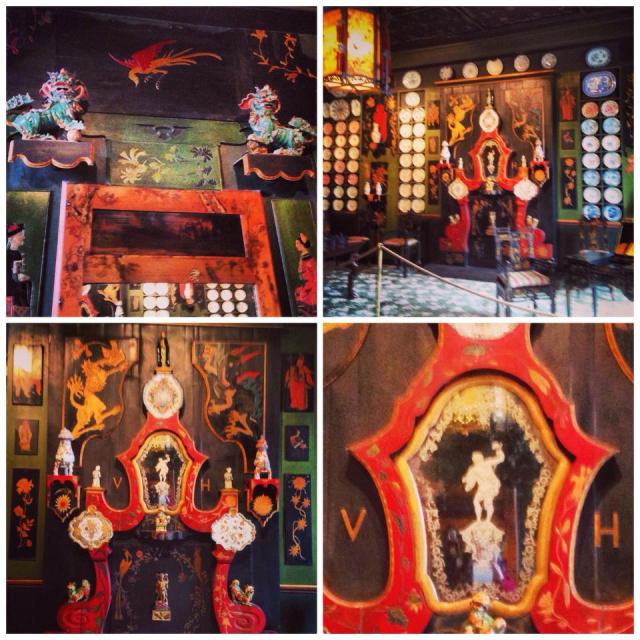
The next room in the apartment features a lot of oriental décor and furniture that originally came from Hauteville Fairy, Juliette Drouet’s house in Guernsey. Juliette Drouet was a long term love and companion of Victor Hugo. The use of plates as décor on the walls was purely for aesthetic reasons – and similar décor can be seen in the china corridor at Hauteville House in Guernsey. If you look closely at the images above, you can see the initials V and H carved into the wooden centrepiece of the room – initials which naturally stood for Victor Hugo. He considered himself to be an artist – at this point in our visit, we were greatly moved by an enthusiastic and informative French school teacher who was praising the island of Guernsey and Victor Hugo’s house there in front of a large group of French school children wielding clipboards. More information about Victor Hugo’s apartment in Place des Vosges can be found at the following link – http://maisonsvictorhugo.paris.fr/fr/musee-collections/visite-de-lappartement
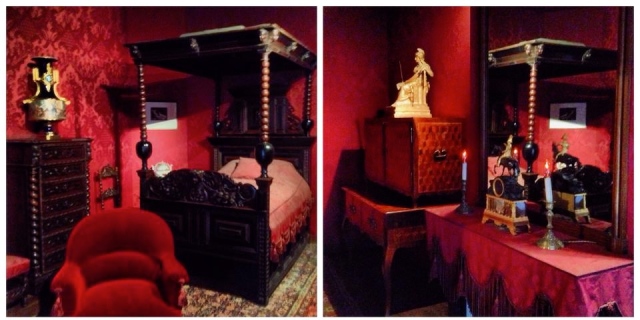
My favourite room of the apartment was Victor Hugo’s bedroom – the furniture from this room actually came from a different parisian residence of Victor Hugo and was donated to the museum several years later by his grandchildren. It was in this bed on the 22nd May 1885 that Victor Hugo died at the age of 83. Over two million people attended his funeral, following the procession of a national hero in a pauper’s coffin all the way from the Arc de Triomphe to the Panthéon. He now lies in the building dedicated to ‘les grands hommes’ next to two other great French authors – Alexandre Dumas, author of ‘The Three Musketeers’ and Emile Zola, author of ‘Germinal’ and many other French classics.
 After leaving Places des Vosges and having a brief shopping detour, we were back on the trail of Victor Hugo – destination Panthéon. We passed the bell-tower of a former church, the Tour-Saint-Jacques on rue de Rivoli and were momentarily perplexed by the sight of a juggler juggling in front of a line of traffic on the avenue Victoria. The Tour-Saint-Jacques was built in the early 1500’s and unveiled after three years of extensive restoration by the city of Paris in 2009. We hopped on the bus, waved our Navigo passes and headed to the Latin quarter to marvel at the necropolis of the Panthéon – the resting place of many of France’s greatest men… and multiple Nobel Prize winner Marie Curie, the first female French citizen to be recognised for her achievements and contributions to France by being buried in the Panthéon. She was interred in the Panthéon in 1995, 61 years after her death.
After leaving Places des Vosges and having a brief shopping detour, we were back on the trail of Victor Hugo – destination Panthéon. We passed the bell-tower of a former church, the Tour-Saint-Jacques on rue de Rivoli and were momentarily perplexed by the sight of a juggler juggling in front of a line of traffic on the avenue Victoria. The Tour-Saint-Jacques was built in the early 1500’s and unveiled after three years of extensive restoration by the city of Paris in 2009. We hopped on the bus, waved our Navigo passes and headed to the Latin quarter to marvel at the necropolis of the Panthéon – the resting place of many of France’s greatest men… and multiple Nobel Prize winner Marie Curie, the first female French citizen to be recognised for her achievements and contributions to France by being buried in the Panthéon. She was interred in the Panthéon in 1995, 61 years after her death.
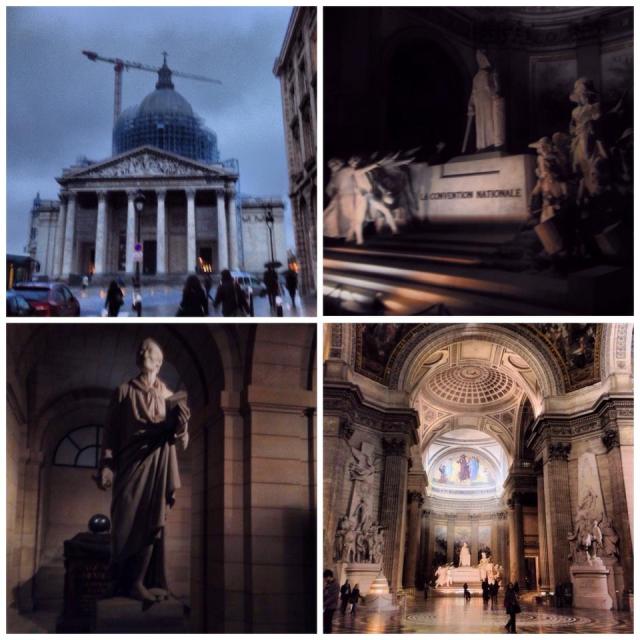
The building is open from 10am-6pm October-March and 10am-6:30pm April-September. Being under 26, we were admitted for free into the building with a quick showing of our identity cards. Art and architecture students often come to the Panthéon to sketch the ornate stonework and to contemplate – on our visit there were several students wandering the building armed with sketchpads and pencils, lost in their thoughts. As time was ticking, we made our way to the crypts first, as we had been advised that the tombs would be closing early.
In the serene haven of the crypt, the tombs are bathed in a warm and calming glow.
In the picture above, the tomb of Victor Hugo is featured bottom left – here in the depths of the Panthéon, Victor Hugo lies in quiet repose opposite Emile Zola. The tomb of Alexandre Dumas is slightly raised above the other two at the back of the vault.
I found visiting the grave of Victor Hugo to be a particularly emotive experience – it’s overwhelming to think of all that he contributed to society – artistically through his books, drawings and artworks and politically through his personal beliefs – the beliefs that he wasn’t afraid to share with the rest of his country. He stood up for democracy and fought for the right of the underdog – even if taking such a radical approach meant being exiled from his beloved country. His tomb – along with the tombs of French abolitionist writer Victor Schœlcher, French socialist leader Jean Jaurès and Jean Moulin, a member of the French resistance who was killed by the Gestapo in 1943, Louis Braille, Voltaire, Rousseau, Emile Zola, Alexandre Dumas and Marie Curie – has a simple yet imposing design in white stone with clean lines. However, when you stand before any of the tombs in the Panthéon, it is a humbling experience to think of all the human beings buried there, who achieved and contributed so much for France during their time on this Earth.
The Panthéon sits on the Montagne Sainte-Geneviève, on the former site of the Abbey of Sainte-Geneviève which originally contained the relics of the saint in a holy chest. In the picture above, top right you can see the tomb of Rousseau, as well as a replica of the Panthéon top right and bottom left. Bottom right, you can see a monument dedicated to Léon Gambetta. The heart of Léon Gambetta – an important political figure – was displayed as a relic in the Panthèon for three days before being sealed away in an urn its current resting place in another area of the building. According to historians Susan K. Foley and Charles Sowerwine, his heart was an important symbol and metaphor for his patriotism and passion for France (Foley, Sowerwine 2012:243)
As it was nearing closing time and Ombeline had a class to go to, we decided to bid adieu to the great men (and women) of the Panthéon, heading outside into a tranquil dusky evening. We stopped to look at the buildings of the Sorbonne Law School before continuing onwards through the alleyways of the Latin quarter in search of a snack. Running commentary of the sights and hotspots of the vibrant Latin Quarter was provided by Ombeline – thanks go to Ombeline for a great day of culture and catch up in Paris!
NOTE TO READER:
If you are interested in learning more about Victor Hugo, then I would strongly recommend having a read of Graham Robb’s ‘Victor Hugo: A Biography’. The Panthéon also has its own website http://pantheon.monuments-nationaux.fr which can be consulted for further information.
A (very short) bibliography
Foley, Karen K, Somerwine, Charles (2012) ‘A Political Romance: Léon Gambetta, Léonie Léon and the Making of the French Republic, 1872-82′ Great Britain: Palgrave Macmillan
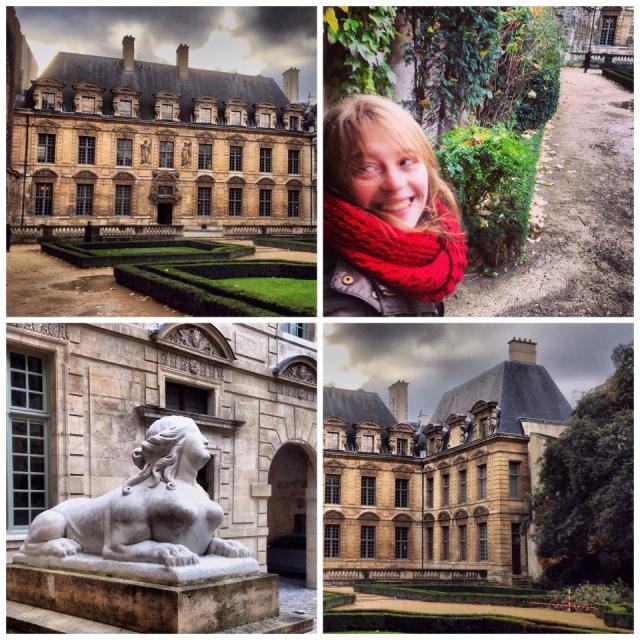
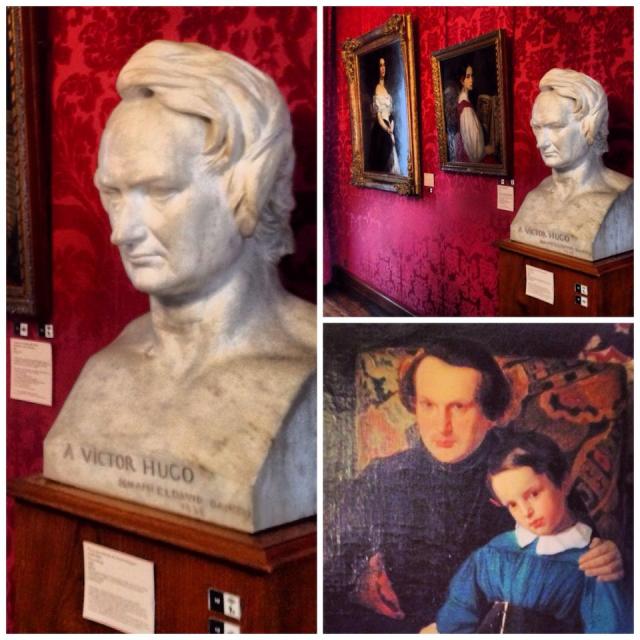





Merci for the Graham Robb/Victor Hugo recommendation.
No problem! I worked for a while as a Victor Hugo guide in Guernsey and found it made for useful and entertaining reading.
Groupie en chef de Victor Hugo ! Tu pourrais écrire une biographie, ou mieux, une fiction sur sa vie, entre Guernsey et Paris! Bon, c’est malin, j’ai envie de voir L’Histoire d’Adèle H maintenant… 😀 ❤
How sad to lose four children in one’s own lifetime. Thanks for the guided tour, Louise, especially of Victor Hugo’s apartment. I love the rich decor of Le Salon Rouge.
Thanks for commenting. Victor Hugo certainly did experience a lot of tragedy in his lifetime. However, he was adept at making the most of a bad situation and he was able to overcome adversity – channelling his thoughts, emotions and experiences into his compelling works of literature, artwork and even design – his house in Guernsey is truly sublime and the themes encountered in the decor can be interpreted in many different ways!
One of my favourite books by Hugo is one of his last ever works ‘The art of being a Grandfather’. It’s a volume full of charming poems about his grandchildren Georges and Jeanne – after losing four children in tragic circumstances, it’s comforting to see the light and joy that his grandchildren brought to his life.
You are obviously a great admirer of Victor Hugo, and passionate about his works.
I remember studying Hugo in school, but I have to admit the details were fuzzy….thank you for the refresher course. The tour was beautiful!
Thanks for commenting, Elisa! I’m no true expert, but being a dual national of both France and Guernsey and a former literature student to boot, I admire Victor Hugo greatly – he is definitely one of my top heroes from French history (alongside Joan of Arc, but that’s a story for another day!)
I enjoyed your photos and discussion about Hôtel de Sully and Victor Hugo.
Thank you very much for commenting! It was a pleasure for me to write about these beautiful locations and I’m glad that you enjoyed my post!
I love the cemeteries and crypts of Paris. I always spend a good deal of time at Pere laChaise when I’m there.
Have you been to the catacombs? I still haven’t made it to Père Lachaise but it is on my to do list!
I haven’t been to the catacombs but it’s on MY to do list! 🙂 (You’re lucky, you’re a lot closer. 😉
I love how this is tied together by symbols and their meanings. Victor Hugo brought meaning to so many, via his literary and other works (“words are but the means to meaning”); Gambetta’s heart was given meaning as a political symbol by its display; and the Panthéon, such a dominating piece of architecture, is ultimately given meaning by the minds resting within it.
A lovely post!
Interesting opost… 🙂
Victor Hugo is one of my favorites
– and an inspiring reason for learning french in my younger days… 🙂
I love that he inspired you to learn French – thanks for commenting!
Loved both the photos and the story. And is it just me, or does Victor Hugo look a bit like actor David Thewlis of the Harry Potter movies? 😉
Thanks for reading and commenting! Interesting point about David Thewlis – I think that they do actually have quite similar ‘stoic’ expressions!
You were in my quartier 🙂 ! Next time, let’s meet for a coffee. In that area (Place des Vosges), there is a cute restaurant called Chez Janou. Trendy but le vieux Paris at the same time. Do you know it? Try!
I don’t know it! Next time I’m in Paris (could be sooner rather than later) I’ll let you know! 😀
chezjanou.com
It is young and fun, food pretty good.
Not a proper restaurant review, but you can get a feeling of the bistrot: http://pearlspotting.wordpress.com/2013/01/21/highlighs-of-paris-weekend/
Will have a read! Looks like a cute intimate place – love the ‘Midnight in Paris’ reference!
A bit noisy but at the same time intimate.
And when you go, order la mousse au chocolat. Très spécial 🙂
Love the shots and all the rich history.
Thank you for commenting 🙂 Glad you enjoyed the post!
Great photos, great description of history 🙂 Now all I want to do is just take a plane and fly over to France!
Thank you for your lovely comment! ^____^ As Audrey Hepburn famously said… “Paris is always a good idea” 🙂
wonderful post, Louise, dedicated to one of the titans of the world’s literature… congrats! I love his works and Audrey Hepburn, too! 🙂
amitiés toulousaines, bonne soirée et merci pour ton passage à mon aire de jeux… 🙂 cheers et à+! Mélanie
Thank you Mélanie! It’s always an honour to dedicate a bit of time to Victor Hugo! 😀 Thanks for taking the time to post a comment!